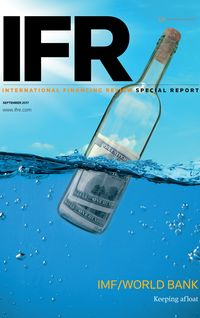Green bond issuance from the Emerging Markets represented close to half the total deal volume for 2016. The numbers suggest that EM is well on the way to enticing private investment flows into addressing its huge sustainability requirements. EM may represent half the Green bond volumes, but it is only half the sustainable story.
The Green bond market made great strides towards maturity in 2016 as new issue volumes almost doubled from 2015, peaking near the US$100bn mark – depending on the definition of Green, that is. Of that, roughly half the paper came from EM borrowers.
“It was a breakout year for EM Green bonds in 2016,” said Rahul Ghosh, senior vice-president, ESG and Green Bonds, at Moody’s Investors Services. “According to our numbers, EM contributed around 48% of global supply, which is an impressive leap from the 9% contribution it made in 2013.”
It is a positive story in terms of direction, but whether the recent rapid pace of expansion can be sustained remains to be seen. The reason for caution is the importance of China.
China, China, China
China dominates Green bonds. Chinese issuers contributed 39% of the market in 2016, according to Climate Bonds Initiative (CBI). And in its turn as head of the G20, China played an enthusiastic role in promoting green finance domestically and internationally.
“You can split EM into China and the rest,” said Stephanie Sfakianos, head of sustainable capital markets at BNP Paribas. “China has taken a unique approach to embedding green finance into its local market, which has encouraged an active issuer base. There are definitely aspects of their model that could be emulated in other markets.”
Anyone who is anyone in Green bonds is courting China: the China-UK Green Finance Collaboration Taskforce is increasing financial cooperation and growing investment; the European Investment Bank and the People’s Bank of China have a joint initiative to combine policy and market best practice; and the Shanghai Stock Exchange and Luxembourg Stock Exchange have agreed to display a Green bonds index on both exchanges. The list of initiatives goes on.
The influence of China is also reflected in recent issuance statistics. For the first quarter of the year, according to CBI, China was responsible for less than 4% of deal volume. That slowdown in activity led pundits to downgrade their overall supply targets for the whole year.
It demonstrates the importance of China to Green bonds in general, but also illustrates that China is not representative of EM, where issuance remains relatively small. Nevertheless, there is progress.
“Even excluding China, the EM story remains reasonably constructive,” said Ghosh. “Volumes have grown every quarter for the last year, although issuance is more fragmented and opportunistic. Deals tend to be small and there have, so far, been few repeat issuers.”
Indeed, there have been plenty of ‘firsts’ over the year from borrowers keen to showcase their climate credentials. Inaugural deals have appeared from new issuers (Lithuania’s Lietuvos Energija), new geographies (NBAD from the Gulf), and in new formats (the first Green sukuk).
Not in the mainstream
The real stumbling block to EM bond growth, however, is that it is clearly not a mainstream asset class. It is more the case that EM Green bonds in the past have mostly been bought by specialist EM investors rather than those dedicated to the ‘green’ cause.
The demand is there, but it is mainly in the hands of investment-grade credit buyers. There is a relative paucity of bankable deals in general – particularly in EM.
“It’s not just about finding the money,” said Sfakianos; “there’s plenty of that to go into the market. It’s more about finding enough projects of financeable status for them to buy – and that will need some assistance.”
It will take the participation of a host of market participants to facilitate the flow of Socially Responsible Investing assets under management into the hands of sustainably-driven EM issuers.
But the imperative is there. Estimates point to a need for as much as US$53trn in infrastructure investment to reach the two-degree Celsius climate change target by 2030.
”The point is, the task is huge,” said Noritaka Akamatsu, technical advisor for finance at the Asian Development Bank. “The political will to address climate change is there and governments and public bodies will play major roles, but public institutions cannot finance it alone. They need to leverage in private investment.”
Sovereigns can help in terms of creating the right environment to support development, and there are many country-specific and regional initiatives under way that aspire to nurture the market.
Green bond guidelines have been published in India and are soon to appear from the Association of South-East Asian Nations. Affiliations have emerged between stock exchanges, investor groups, multi-national development banks (MDBs) and governments in Latin America, and there is the promise of sovereign issuance from Africa. Conferences abound as the key players look to raise the level of understanding in nascent markets.
“Collaboration and education is vitally important in order to ensure the adoption of best practice,” said Jaspreet Duhra, senior client relations manager at oekom research. “The rate of compliance to our sustainability standards is low within most EM companies, so local efforts in raising awareness and providing the type of incentives that align the markets with national goals and international guidelines are very important.”
Easing the flow
The MDBs will play their part in encouraging the flow of funds towards EM. They already finance and advise on projects that support development, and they were also instrumental in the birth of the Green bond market.
Some 10 years ago, the EIB and the World Bank were among the first to issue bonds in response to investors wanting to reduce climate risk levels in their portfolios.
“For investors wanting to mitigate climate risk and make a positive impact with the fixed income part of their portfolio, it is easier to buy a bond from the World Bank that supports certain types of projects than to directly allocate to individual projects and take project risk,” said Heike Reichelt, head of investor relations at the World Bank.
“We have a framework to identify eligible projects that seek to mitigate climate change and help countries increase climate resilience, measure the impact and report on it. Investors benefit from the World Bank’s own project due diligence and credit.”
Green bond issuing programmes of MDBs are one way of raising funds from fixed income investors for sustainable projects, but it is not the only solution.
“The ADB’s partial guarantee to the first Green bond in the Philippines (the Tiwi and MakBan Geothermal Climate Bond) is an example of how MDBs can attract private investment into projects,” said Akamatsu. “We can also encourage wider participation in bonds as a cornerstone investor.”
By identifying projects and supporting the associated bond, MDBs can attract private finance, but it is the local banks that really stand as the gateway to greening home markets.
Yield and impact
It is the logic behind one of the major initiatives of the year: the establishment of the Green Cornerstone Bond Fund (GCBF). The US$2bn fund – the world’s largest Green bond fund dedicated to emerging markets – is the product of World Bank affiliate, IFC, and European fund manager Amundi.
IFC will invest up to US$325m in the fund, which plans to buy Green bonds issued by banks in Africa, Asia, the Middle East, Latin America, Eastern Europe and Central Asia. Amundi is tasked with raising the rest of the US$2bn from institutional investors and will provide its services in managing emerging market debt.
“The goal is to crowd in private investment into a market that doesn’t really exist,” said Sergei Strigo, head of emerging market debt management at Amundi . “Banks are the conduit for green projects in the EM world.”
The concept has been welcomed by the market and the fund has encountered a positive reception during its marketing phase, according to Strigo – from both EM and SRI investors. One obvious attraction, other than green considerations, is IFC providing the first loss to the fund by taking the junior tranche of a structure that also includes mezzanine as well as senior tranches.
“Investors accept the premise behind the fund and like the idea of yield with impact,” said Strigo. “The fund will offer a higher yield than on Green bonds in the developed markets.”
Commentators say that just as important is the role IFC is playing in providing technical assistance; issuing green is not a straightforward process, neither is it without costs. The educational process is necessary, however, since any bonds bought by the fund must adhere to the Green Bond Principles and the highest possible standards of transparency.
“We are addressing the demand and supply side of the market,” said Strigo.
The fund aims to be fully invested within seven years and it hopes to start buying in the fourth quarter from a market of, admittedly, limited supply.
The GCBF is just one of the many initiatives under way to promote a greening of the emerging markets but there is still a lot to do in order to spread the word not only to its issuers but also to investors.
“There are challenges on the demand side for international investors but there are also challenges for investors within the domestic markets,” said Ghosh. “We’re just not seeing the same momentum to embrace SRI in the EM investor base.”
In its 2016 review, the Global Sustainable Investment Alliance highlighted that of the global pool of assets managed using one or more sustainable investment strategies, which it estimates at close to US$23trn, Asia (excluding Japan and Australia) represents just US$52bn.
It is clear that it is going to take some time before EM is in the right place to take advantage of growing demand for SRI opportunities.
To see the digital version of this report, please click here.
To purchase printed copies or a PDF of this report, please email gloria.balbastro@tr.com



